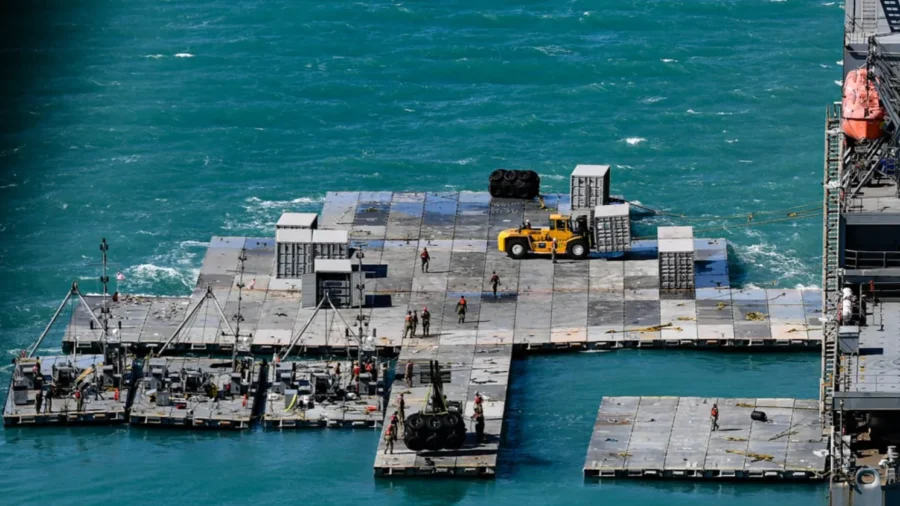Mortar strikes were reported landing in the Gaza Strip on Wednesday in the vicinity of a site that’s been selected for a humanitarian pier.
In March, President Joe Biden ordered the U.S. military to construct a pier along Gaza’s Mediterranean coastline, to facilitate increased deliveries of food and humanitarian supplies in the embattled territory.
The pier project, known as a joint logistics over-the-shore (JLOTS) mission, entails constructing a temporary pier at sea and connecting it to a shoreline. While the U.S. military has begun constructing the pier at sea, the designated section of coastline for which the pier will be eventually connected reportedly came under indirect fire on Wednesday.
Israel Defense Forces (IDF) are currently guarding the designated shore connection point for the JLOTS pier. An IDF official told the Times of Israel that the mortar attack landed as United Nations officials were touring the pier site, and that Israeli troops rushed the U.N. officials to a shelter.
The IDF reported no injuries from the attack.
“We’re aware of reports that a small number of mortars landed in the vicinity of the marshaling yard area for humanitarian assistance that will eventually be the delivery site that this pier will support,” U.S. Air Force Maj. Gen. Pat Ryder, the Pentagon press secretary, said at a Thursday press briefing.
Maj. Gen. Ryder reiterated that JLOTS pier is being assembled at sea, and thus U.S. personnel were not in range of any mortar fire.
“And as I understand it, there’s no U.S. equipment per se in this marshaling yard,” the Pentagon spokesman added.
Pier Construction and Force Protection
Speaking at an officially organized press call later on Thursday evening, a senior U.S. military official said on background that the U.S. does not believe the reported mortar attack had anything to do with the JLOTS pier mission in particular or with the delivery of humanitarian aid from the sea.
No group has claimed responsibility for the attack. Khalil Al Hayya, a senior representative of the Hamas terrorist group, did tell The Association Press on Wednesday that the group views the presence of Israeli forces or any other foreign forces stationed by the pier as an act of occupation and aggression that they would resist.
During the background press call on Thursday, the senior U.S. military official gave assurances that U.S. personnel will be safe when the JLOTS pier is eventually linked up to the shoreline. He said commercial ships will use a floating platform at sea to transfer aid deliveries to U.S. Army logistics support vessels and Landing Craft Utility vessels, which will then travel to a causeway affixed to the Gaza shoreline. He said the trucks will carry the supplies off the Army support vessels and over the causeway, onto the sand, and into the marshaling area.
The senior military official also added that the current “defensive umbrella” around the aid delivery site and the JLOTS pier “looks nothing like it’s going to look like when we actually execute the mission.” The military official said the eventual defensive framework for the pier will be “far more robust” and there will be a daily assessment of force protection and security.
The senior military official said the JLOTS pier will likely be operational in early May.
Supplies flowing through the JLOTS pier will first be inspected in the Mediterranean country of Cyprus.
The Humanitarian Situation in Gaza
The completion of this temporary pier will come more than six months on in the war in the Gaza Strip between Israel and Hamas. At an April 10 congressional hearing, U.S. Agency for International Development (USAID) Administrator Samantha Power said that a state of famine likely has already begun in parts of the Gaza Strip amid the ongoing fighting.
Ms. Power said around 500 commercial and humanitarian trucks had enter the Gaza Strip on a daily basis prior to the start of the conflict.
In testimony before Congress earlier this month, the USAID administrator said the flow of supply trucks into the Gaza Strip had remained well below pre-war levels for months but had recently risen to around 400 a day. Philippe Lazzarini, the commissioner-general for the United Nations Relief and Works Agency, offered a far lower assessment this week, putting the average daily number of aid trucks flowing into the embattled territory in April at 192.
In her April 10 remarks, Ms. Power concluded that even with 400 truckloads of humanitarian supplies going into the Gaza Strip each day, there’s still a long way to go in assisting the civilian population there.
“The destruction of greeneries, and markets, and arable land, and then the fact that so few trucks got in over so many months means we have massive catch-up to do,” she said.
The U.S. Department of Defense has said the JLOTS pier will be able to support around 90 truckloads of supplies each day when it reaches its initial operational capacity, and then scale to up to 150 truckloads once fully operational


